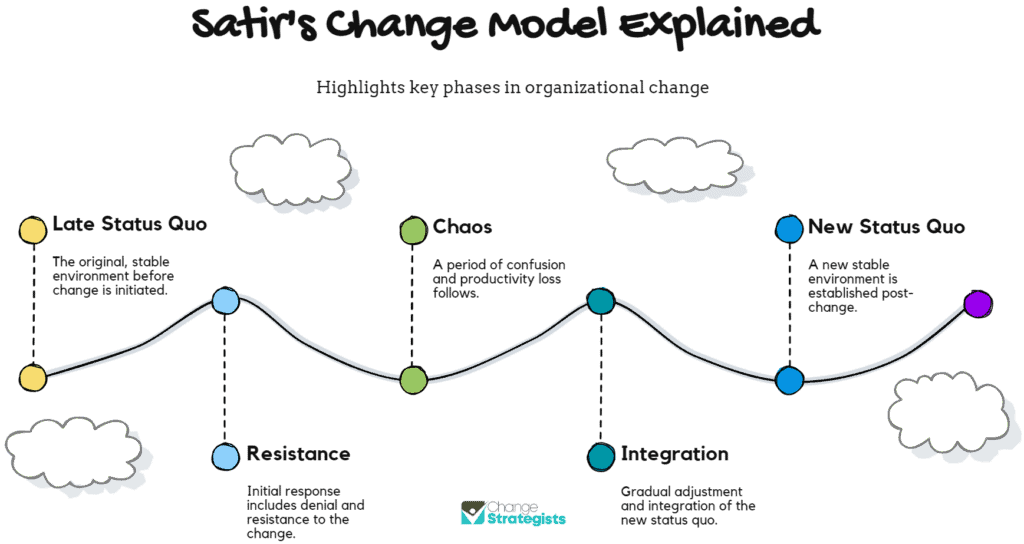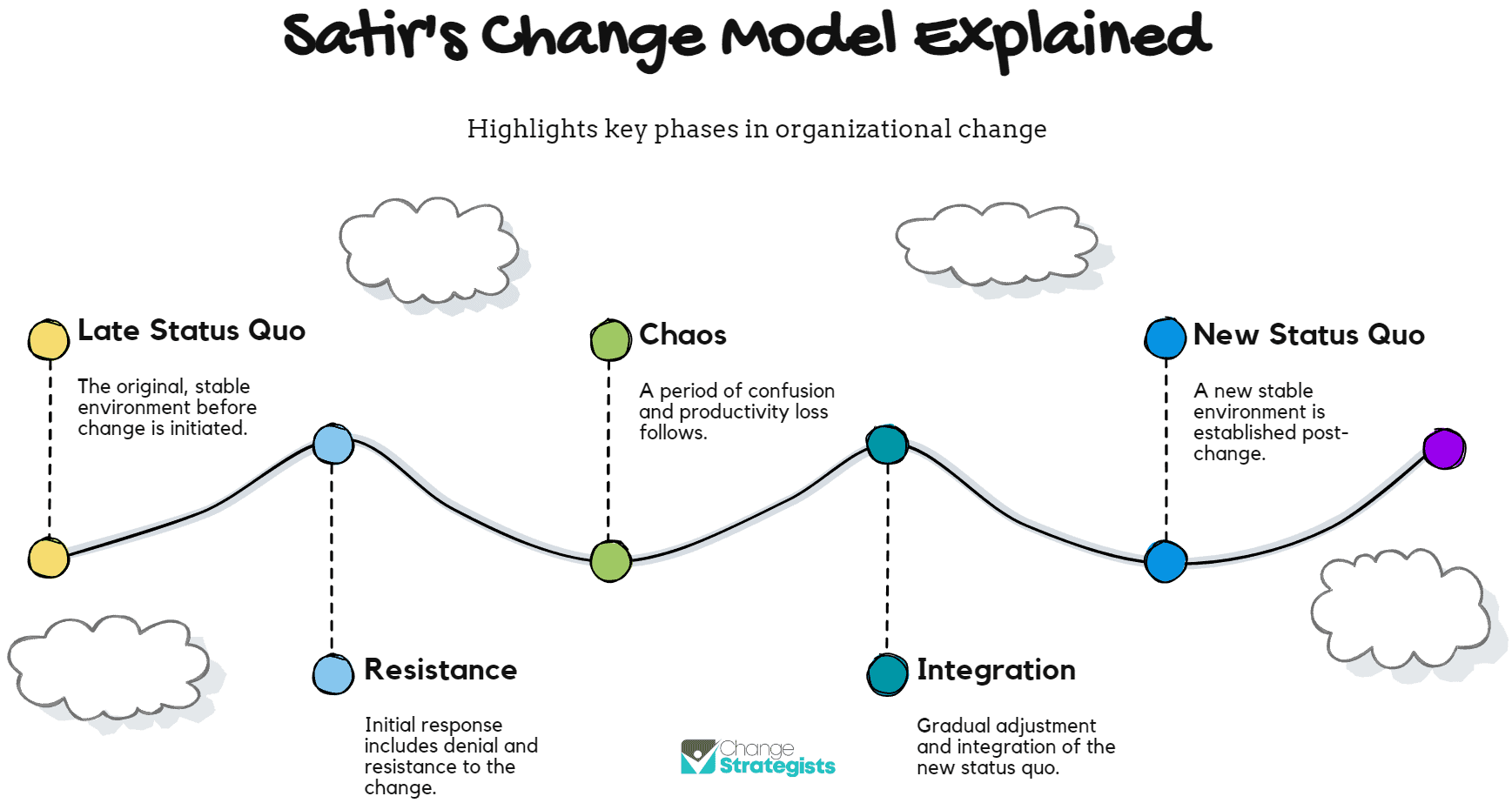Change is inevitable in any organization, and managing it effectively is crucial for success. One widely recognized approach to change management is the Satir Change Management Methodology. Developed by renowned family therapist Virginia Satir, this methodology provides a structured framework for understanding and implementing change within organizations.
In this article, we will explore the key principles and stages of the Satir Change Management Methodology, as well as its benefits and challenges. We will discuss how to implement this methodology in your organization. Whether you are a business leader, manager, or consultant, understanding the Satir Change Management Methodology can provide valuable insights into navigating and leading change within your organization.
Key Takeaways:
- Satir Change Management Methodology is a structured approach to managing change that focuses on the human element of the change process.
- It was developed by Virginia Satir, a renowned family therapist, and is centered on five stages: recognizing the need for change, preparing for change, implementing change, integrating change, and stabilizing change.
- The benefits of using this methodology include improved communication, increased employee engagement, and smoother transitions during times of change. However, challenges may arise when implementing it, such as resistance to change and the need for strong leadership.
What is Change Management?
Change management refers to the structured approach of transitioning individuals, teams, and organizations from a current state to a desired future state, ensuring that the change is implemented smoothly and effectively.
Organizational change is a complex process that demands a well-crafted change model and strategic management. The management plays a pivotal role in not just driving change but also in facilitating the transition and ensuring that the change is embraced at all levels within the organization.
The application of a robust change model helps in identifying the necessary steps, potential obstacles, and the impact of change on the organization’s processes and people.
What is the Satir Change Management Methodology?
The Satir Change Management Methodology, also known as the Satir Change Model, is a transformative approach developed by Virginia Satir, a pioneer in the field of family therapy, focusing on the emotional impact and human dynamics associated with change.

Virginia Satir’s approach revolutionized traditional change management methods by recognizing the profound emotional impact that change can have on individuals and their relationships. She emphasized the importance of addressing these emotional responses to create sustainable and meaningful change within organizations.
The unique aspect of the Satir Change Model is its human-centered approach, placing people at the heart of the change process. This method acknowledges that change is not just a technical or structural process but deeply intertwined with the individuals involved.
Virginia Satir’s influence on the Satir Change Model lies in her profound understanding of human dynamics and her ability to integrate psychological insights into practical strategies for managing change.
Who Created the Satir Change Management Methodology?
The Satir Change Management Methodology, also known as the Satir Change Model, was created by Virginia Satir, a renowned psychotherapist and author recognized for her influential work in family therapy and human development.
Virginia Satir, often referred to as the ‘Mother of Family Therapy’, revolutionized the field with her humanistic approach to therapy. Her emphasis on communication, self-esteem, and personal growth laid the foundation for the Satir Change Model. Through her extensive work, Satir developed methods to improve relationships and address dysfunctional family patterns. Her concepts of congruence, self-awareness, and self-acceptance shaped the principles of the Satir Change Model, making it an influential approach in therapy and organizational development.
What are the Key Principles of the Satir Change Management Methodology?
The Satir Change Management Methodology operates on several key principles, including embracing the chaos phase as a natural part of change, fostering the integration stage, and establishing a new status quo that reflects the transformative journey.
Virginia Satir, known as the ‘Mother of Family Therapy,’ developed the Satir Change Model to guide individuals and organizations through the complex process of change.
The chaos phase, a pivotal stage in the Satir Change Model, involves the disintegration of the old patterns and beliefs, creating a sense of uncertainty and discomfort.
As the journey progresses, the integration stage fosters the emergence of new perspectives, behaviors, and relationships, paving the way for the establishment of a new status quo that aligns with the desired transformation.
What are the Stages of the Satir Change Management Methodology?
The Satir Change Management Methodology encompasses distinct stages, including recognizing the need for change, preparing for change, implementing change, integrating change, and stabilizing the new status quo, all while addressing potential resistance and emotional barriers.
Each stage of the Satir Change Model holds great significance in the change management process. The integration stage is particularly crucial as it involves weaving the newly initiated changes into the fabric of the organization’s culture and practices.
During this stage, it’s essential to acknowledge and address any resistance that may arise. This can manifest in various forms, such as skepticism, reluctance, or fear of the unknown.
Navigating the emotional impact of change is an integral part of the process. Leaders and change agents must cultivate empathy and understanding to support individuals through this transitional phase.
How Does the Satir Change Management Methodology Work?
The Satir Change Management Methodology operates by facilitating transformational shifts within individuals and organizations, guiding them through the complexities of change and supporting the emergence of a new, enableed state.
This methodology, developed by renowned family therapist Virginia Satir, is deeply rooted in fostering sustainable and lasting change. It leverages a variety of techniques and interventions, emphasizing the enablement of individuals and organizations to embrace change proactively. By addressing both the emotional and intellectual aspects of transformation, the Satir Change Model helps individuals and organizations navigate the challenges of change with resilience and adaptability.
The emphasis on fostering open communication and healthy relationships is a core tenet of this methodology, serving as a catalyst for positive transformation at all levels of an organization.
Recognizing the Need for Change
Recognizing the need for change involves acknowledging the emotional impact, understanding the implications for transformation, and identifying the catalysts that necessitate a shift towards a new direction.
Within the Satir Change Model, the awareness of needing change often starts with an unrest or dissatisfaction in the current state. It’s essential to delve deeper into the underlying emotions and their roots. This introspection can lead to a realization of the potential for growth and improvement.
Understanding the emotional impact of change is a vital component of the Satir Change Model, as it fuels the motivation for transformation. The process involves acknowledging the discomfort that comes with change and accepting it as a natural part of the transformation journey. Identifying the catalysts for change requires a thorough examination of internal and external factors that trigger the need for transformation.
Preparing for Change
Preparing for change involves addressing potential resistance, establishing effective management strategies, and laying the groundwork for a supportive environment that nurtures the forthcoming transformation.
In the Satir Change Management Model, acknowledging and managing resistance plays a crucial role in successful change implementation. It entails understanding the reasons behind resistance, communicating openly with the team, and involving them in the change process.
Effective management involves not only planning and executing the change but also providing necessary support and resources. Creating a supportive environment involves fostering a culture of trust, open communication, and resilience to navigate through the change effectively.
Implementing Change
Implementing change involves managing the emotional impact, orchestrating organizational shifts, and ensuring that the transformative vision is effectively translated into actionable strategies and initiatives.
Within the Satir Change Model, navigating through the emotional responses of individuals within an organization becomes a critical task. Understanding the fear, resistance, and uncertainty that change often evokes is essential for effective management. Simultaneously, the dynamics of organizational change must be acknowledged, recognizing the interplay between leadership, communication, and cultural adaptation in driving successful transformations. Ultimately, the key lies in bridging the gap between the envisioned change and its tangible implementation, aligning strategies with the organizational culture and resources.
Integrating Change
Integrating change involves navigating the integration stage, consolidating the new status quo, and facilitating the alignment of individuals and systems with the transformative direction.
During the integration stage of the Satir Change Model, the focus lies on unifying the old and new elements of the system, addressing any resistance, and fostering cohesion. Consolidating the new status quo requires establishing sustainable practices and norms that support the desired changes, creating a foundation for the future. Simultaneously, aligning individuals and systems involves engaging stakeholders, ensuring clear communication, and recalibrating organizational structures to sustain the envisioned transformation.
Stabilizing Change
Stabilizing change involves navigating the chaos phase, fostering stabilization, and addressing the emotional impact to ensure that the transformative changes are effectively embedded and sustained.
The Satir Change Model emphasizes the recognition and management of the chaos phase as a natural part of change. In this phase, individuals may experience heightened emotions, uncertainty, and resistance, making it critical to provide support and guidance. Fostering stabilization involves creating a sense of security, trust, and clear communication to reduce anxiety and promote acceptance. Addressing the emotional impact is essential for sustainable transformation, promoting individual and collective resilience amid change challenges.
What are the Benefits of Using the Satir Change Management Methodology?
The Satir Change Management Methodology offers numerous benefits, including fostering effective organizational change, facilitating transformational shifts, and addressing the emotional dimensions of the change process to create sustainable outcomes.
By focusing on enhancing communication and trust within the organization, the Satir Change Model helps in building cohesive teams and aligning the workforce towards common goals. It also enables leaders to embrace transparency and effectively manage resistance to change, leading to smoother transitions and reduced employee anxiety.
The methodology encourages a culture of continuous improvement, enabling the organization to adapt to evolving market dynamics and technological advancements.
What are the Challenges of Using the Satir Change Management Methodology?
Despite its effectiveness, the Satir Change Management Methodology presents challenges such as managing resistance, addressing the emotional impact, and navigating the complexities of human dynamics within the change process.
One of the key challenges of implementing the Satir Change Management Methodology lies in effectively managing resistance, which often arises due to the natural human instinct to preserve the status quo. It’s crucial to acknowledge and address this resistance through open communication, active listening, and involving employees in the change process.
The emotional impact of change cannot be overlooked. The Satir Change Model emphasizes the significance of understanding and validating the emotions experienced by individuals during change. This requires leaders to create a supportive environment where employees feel heard, valued, and provided with the necessary support to navigate their emotions.
Another aspect that adds complexity to change management is the intricate web of human dynamics. Navigating through varying perspectives, motivations, and reactions within a team or organization demands a high level of emotional intelligence and adept interpersonal skills. Leaders adopting the Satir Change Management Methodology must be able to mitigate conflicts, build trust, and foster collaboration amidst these complexities.
How to Implement the Satir Change Management Methodology in Your Organization?
Implementing the Satir Change Management Methodology in your organization requires strategic planning, effective change management practices, and a holistic approach to addressing the emotional dimensions of change within the organizational context.
To implement the Satir Change Management Methodology effectively, it is essential to establish a clear vision for the desired change, along with a detailed plan mapping the steps toward achieving it. This strategic planning sets the foundation for successful implementation. Effective change management involves fostering open communication, actively involving employees, and providing adequate support throughout the change process.
Addressing the emotional dimensions of change is crucial. Recognizing and validating the emotions that accompany organizational change can help mitigate resistance and facilitate smoother transitions. This involves creating a supportive environment, offering resources for coping with change, and promoting a culture of resilience. By focusing on these aspects, organizations can navigate change more effectively and foster a positive environment for growth.
Frequently Asked Questions
What is the Satir change management methodology?
The Satir change management methodology is an approach to managing organizational change that was developed by family therapist and author Virginia Satir. It is based on the belief that change is an inevitable and necessary part of growth and that successful change requires a holistic and humanistic approach.
How does the Satir change management methodology differ from other change management approaches?
The Satir change management methodology differs from other approaches in that it focuses on the emotional and human aspects of change rather than just the technical or procedural aspects. It also emphasizes the importance of communication, trust, and collaboration among all stakeholders involved in the change process.
What are the key principles of the Satir change management methodology?
The key principles of the Satir change management methodology include the belief that change is a natural process, the importance of self-awareness and self-esteem, the power of open and honest communication, and the need for collaboration and cooperation among all individuals involved in the change process.
How can the Satir change management methodology benefit organizations?
The Satir change management methodology can benefit organizations in various ways, such as fostering a positive and supportive work culture, improving communication and relationships among team members, increasing employee engagement and commitment to change, and ultimately leading to successful and sustainable organizational change.
Are there any limitations to the Satir change management methodology?
Like any change management approach, the Satir change management methodology may have limitations depending on the specific context and organization. One potential limitation is that it may require significant time and effort to implement, as it involves addressing emotional and interpersonal dynamics. Additionally, it may not be suitable for all types of changes or organizations.
How can individuals learn more about the Satir change management methodology?
Individuals can learn more about the Satir change management methodology through various resources such as books, workshops, and online courses. There are also certified practitioners who specialize in this methodology and can provide guidance and support for organizations looking to implement it. Additionally, studying and understanding family therapy and systems thinking can also help individuals gain a deeper understanding of the Satir approach.





